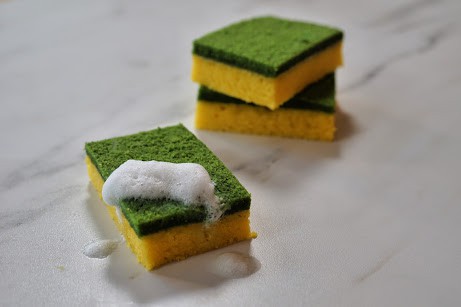It may look like a soapy dish sponge, but it’s nothing more than a delicious illusion cake.
Now this is my first attempt at a look-alike cake, but it’s not the first time I’ve made food that looks like something that it’s not.
For example, I’ve made edible soap and and edible towels. I’ve also made ice cream that looks like fried chicken as well as ice cream that looks like a steak and ice cream that looks like spaghetti.
You can find my Food Look-A-Like Playlist here.
Similarly, this “sponge” cake will not be your typical, boring old sponge cake that grandma used to make.
Instead, it will be a cake that actually looks like the sponge you use to wash your dishes — the ones with the green scrubby top and yellow bottom.
Sounds gross, yes, but trust me, it will be absolutely delicious!
I saw this cake for the first time a few years ago on Pee-wee Herman’s blog. But from what I could gather Chef Ben Churchill was the first to come up with the concept.
More recently, Emma from Emma’s Goodies on YouTube tried it, and so my recipe follows hers with a couple of tweaks.
So Emma’s version is a lemon cake, but because I’m not a huge fan of lemon cakes, I decided to make mine vanilla. You can flavor yours however you like.
Either way, lemon, vanilla, or key lime, it should be delicious, with zero taste of sponge!
Here’s how:

Dish Sponge Cake
Equipment
- Conventional oven
- two (2) 7" square baking pans
- parchment paper
- two (2) mixing bowls
- whisk
- spatula
Ingredients
- 135 g butter (1 stick + 1 T.) softened
- 120 g granulated sugar (1/2 C. + 1 T.)
- 1 tsp vanilla extract
- 3 eggs medium
- 140 g all-purpose flour (1 cup)
- 1/2 tsp baking soda
- 3 tbsp buttermilk or substitute 2 T. lemon juice + 1 T. milk
- food coloring yellow and green
- 1 tbsp honey
Instructions
- Preheat oven to 320℉.
- Using a spatula, work the granulated sugar into the butter until you have a nice cream.
- To the cream, add vanilla extract.
- Using a whisk, incorporate three medium eggs, one at a time, mixing well in between each egg.
- Add flour and baking powder.
- Add buttermilk.
- Mix to combine. (Don't overmix.)
Dyeing the Batter
- Reserve one third of the batter to dye green for the top portion of the cake.
- Use a few drops of the paste food coloring to dye the batter green.
- Pour the batter into a seven inch prepared brownie pan. (I sprayed mine with baking spray and lined it with parchment paper.)
- Repeat the dyeing process with the yellow food coloring for the remaining two-thirds of the batter.
- Using an offset spatula, make sure that the batter is smooth in the pans. (You can give the pans a few swift taps on the countertop to get rid of any bubbles.)
Baking
- Bake in a 320℉ oven (160℃) for ten minutes, initially. (The green cake, because it is thinner, will cook much faster. So start checking it at ten minutes.) When a toothpick comes out clean, it should be done.
- The yellow cake should take an additional five or ten minutes.
- Allow the cakes to completely cool before assembly.
Assembly
- Remove the parchment paper.
- On the yellow cake, spread a layer of honey (about a tablespoon or so), just enough to act like glue.
- With a bread knife, remove a thin layer of the yellow cake around the edges, so it’s nice and fuzzy.
- Using a serrated bread knife, shave off the very top layer of the green cake to make it look fuzzy like the scrubber part of the sponge.
Cutting Cake and Finishing
- Cut cake into equal sponge-sized rectangles.
- To add soap bubbles to your sponge cake, in a mixing bowl, whisk nonfat milk until it forms bubbles.
- With a spoon, scoop bubbles onto top of cake to look like soap.
Loved the recipe–and the video and several other videos and recipes of yours I’ve seen– so creative and fun!
One thing I did wonder about though is: recipe cites using 1/2 teaspoon baking soda but then says to add flour and baking POWDER…still confused as to which one is supposed to use…thanks!